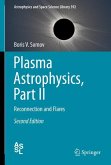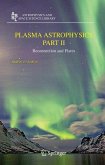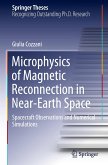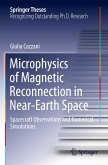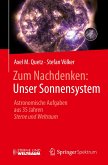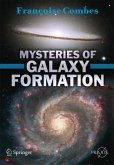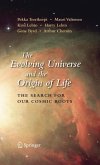Today many scientists recognize plasma as the key element to understanding new observations in near-Earth, interplanetary, interstellar, and intergalactic space; in stars, galaxies, and clusters of galaxies, and throughout the observable universe. Physics of the Plasma Universe, 2nd Edition is an update of observations made across the entire cosmic electromagnetic spectrum over the two decades since the publication of the first edition. It addresses paradigm changing discoveries made by telescopes, planetary probes, satellites, and radio and space telescopes. The contents are the result of the author's 37 years research at Livermore and Los Alamos National Laboratories, and the U.S. Department of Energy.
This book covers topics such as the large-scale structure and the filamentary universe; the formation of magnetic fields and galaxies, active galactic nuclei and quasars, the origin and abundance of light elements, star formation and the evolution of solar systems, and cosmic rays. Chapters 8 and 9 are based on the research of Professor Gerrit Verschuur, and reinvestigation of the manifestation of interstellar neutral hydrogen filaments from radio astronomical observations are given. Using data from the Green Bank 100-m telescope (GBT) of the National Radio Astronomy Observatory (NRAO), detailed information is presented for a non-cosmological origin for the cosmic microwave background quadruple moment.
This volume is aimed at graduate students and researchers active in the areas of cosmic plasmas and space science.
The supercomputer and experimental work was carried out within university, National laboratory, Department of Energy, and supporting NASA facilities.
This book covers topics such as the large-scale structure and the filamentary universe; the formation of magnetic fields and galaxies, active galactic nuclei and quasars, the origin and abundance of light elements, star formation and the evolution of solar systems, and cosmic rays. Chapters 8 and 9 are based on the research of Professor Gerrit Verschuur, and reinvestigation of the manifestation of interstellar neutral hydrogen filaments from radio astronomical observations are given. Using data from the Green Bank 100-m telescope (GBT) of the National Radio Astronomy Observatory (NRAO), detailed information is presented for a non-cosmological origin for the cosmic microwave background quadruple moment.
This volume is aimed at graduate students and researchers active in the areas of cosmic plasmas and space science.
The supercomputer and experimental work was carried out within university, National laboratory, Department of Energy, and supporting NASA facilities.
"Anyone who has spent time engaged in research or in teaching in the field of plasma physics will know that it contains a wide variety of elements, both in terms of the physical theories that support it and the phenomena to which it can be applied. ... those looking for an eventful up-to-date guided tour through some of the key sites of the plasma universe may well find what they are looking for here." (Terry Robinson, The Observatory, Vol. 135 (1248), October, 2015)
"This book is the result of four decades of research work of a well-known specialist, this period has been spent in different frontiers of plasma research. ... congratulations to the author for having written this volume, and warmest stimulations to the readers: they shall be pleased reading this book!" (Iván Abonyi, zbMATH 1306.82001, 2015)
"This book is the result of four decades of research work of a well-known specialist, this period has been spent in different frontiers of plasma research. ... congratulations to the author for having written this volume, and warmest stimulations to the readers: they shall be pleased reading this book!" (Iván Abonyi, zbMATH 1306.82001, 2015)
"'Physics of the Plasma Universe Second Edition' by Anthony L. Perrat is a profound guide dedicated to plasma physics in the Solar System ... . It is addressed to graduate students and researchers working in the field of cosmic plasma. ... The book is an excellent manual for young and experienced scientists interested in plasma physics. ... The second edition incorporates many recent results and makes the book an up-to-date guide through the science of plasma in the Universe." (Alicja Wierzcholska and Hubert Siejkowski, Pure and Applied Geophysics, Vol. 174, 2017)
"Anyone who has spent time engaged in research or in teaching in the field of plasma physics will know that it contains a wide variety of elements, both in terms of the physical theories that support it and the phenomena to which it can be applied. ... those looking for an eventful up-to-date guided tour through some of the key sites of the plasma universe may well find what they are looking for here." (Terry Robinson, The Observatory, Vol. 135 (1248), October, 2015)
"This book is the result of four decades of research work of a well-known specialist, this period has been spent in different frontiers of plasma research. ... congratulations to the author for having written this volume, and warmest stimulations to the readers: they shall be pleased reading this book!" (Iván Abonyi, zbMATH 1306.82001, 2015)
"Anyone who has spent time engaged in research or in teaching in the field of plasma physics will know that it contains a wide variety of elements, both in terms of the physical theories that support it and the phenomena to which it can be applied. ... those looking for an eventful up-to-date guided tour through some of the key sites of the plasma universe may well find what they are looking for here." (Terry Robinson, The Observatory, Vol. 135 (1248), October, 2015)
"This book is the result of four decades of research work of a well-known specialist, this period has been spent in different frontiers of plasma research. ... congratulations to the author for having written this volume, and warmest stimulations to the readers: they shall be pleased reading this book!" (Iván Abonyi, zbMATH 1306.82001, 2015)


